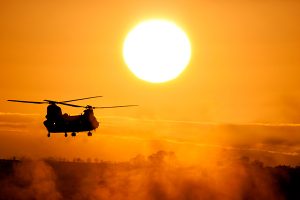OMT: The military pilot’s drug-free treatment option
Last August, underneath a canopy on a beach in Key West, Florida, soldiers lined up behind Lt. Col. Natalie Nevins, DO, to receive osteopathic manipulative treatment (OMT) on their first day off in over two weeks.
Across the world, Capt. Matthew Puderbaugh, DO, was on a mission in Poland where he, too, watched airmen form a line to receive manipulation on an OMT table he’d made from two crates stacked alongside each other.
Dr. Nevins and Dr. Puderbaugh use OMT as a non-pharmacological treatment for back pain, muscle spasms, and other conditions in military pilots.
Health concerns for military pilots
Spending long hours in a small cockpit flying high-stress missions is mentally and physically trying. Narcotics and muscle relaxants relieve physical pain, but are off limits for working military pilots. Enter OMT.
“OMT helps to keep pilots in the air because muscle relaxers and narcotics are grounding medications,” says Dr. Puderbaugh, a flight surgeon with the 37th airlift squadron at the Ramstein Air Base in Germany.
Osteopathic flight surgeons not only keep military pilots in the air, but can also detect unreported injuries, says Dr. Nevins.
“Pilots know flight surgeons can ground them, so they don’t always want to be forthright about areas that are bothering them,” says Dr. Nevins. “I have a great relationship with my pilots because they know I can do something about what’s going on without making them incapable of flying.”
Common conditions
Dr. Puderbaugh frequently uses OMT to treat upper respiratory infections, neck and shoulder pain, as well as headache disorders.
“I performed manipulation on a patient who had severe post-traumatic headaches,” says Dr. Puderbaugh. “Within two sessions, the patient had reduced her narcotic medications and was back to working a full-duty day.”
He also relies on OMT as a diagnostic tool.
“I might not always have access to advanced imagining, so OMT and my palpatory skills have been beneficial in deciding whether or not a patient needs an aeromedical evacuation,” he says.
OMT in demand
Both DOs say their OMT skills are in high demand, with the treatment widely recognized within the military as instrumental for pilots and other service members.
“When the military finds out you’re a DO who does manipulation, it spreads like wildfire,” says Dr. Nevins, who estimates she’s saved the military around $250,000 in physical therapy referrals over six months.
Dr. Puderbaugh agrees.
“Once people learn you can do OMT, it opens up the floodgates,” he says.
